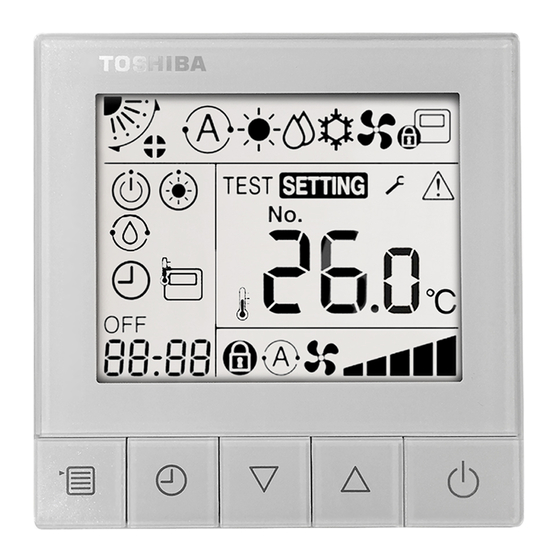Advertisement
Pocket Quick
Reference Guide
On the
TOSHIBA
Compact Simple Wired
Remote Controller
RBC-ASCU11-E
Cool Designs Ltd makes every effort to ensure that the information provided within this publication is correct and error free, however we cannot guarantee that it is free of inaccuracies, errors, or
omissions. Users should seek to clarify this information for themselves prior to basing any decisions upon such information.
Advertisement
Table of Contents

Summary of Contents for Toshiba RBC-ASCU11-E
- Page 1 Compact Simple Wired Remote Controller RBC-ASCU11-E Cool Designs Ltd makes every effort to ensure that the information provided within this publication is correct and error free, however we cannot guarantee that it is free of inaccuracies, errors, or omissions. Users should seek to clarify this information for themselves prior to basing any decisions upon such information.
-
Page 3: Monitor Function
Toshiba air conditioning’s Latest addition to their wired remote controller portfolio. 86mm The RBC-ASCU11-E. A small, 86 x 86 x 16mm wired remote controller, With simple control keys, (5). Large backlite LCD display. Fault Diagnostics. Monitor Function. DN Code access. -
Page 4: Automatic Mode
Buttons Menu. Timer. Up/ Down. Power Button, illuminated when system is ON Blinks when a fault is detected or when a protection device activates. Display, Top line. Louver position. Automatic Mode. Heat Mode. Dry Mode. Cool Mode. Fan Only Mode. Central Control Indicator. - Page 5 Display middle Right. Protection device activated. SETTING. System auto checking after power down. Temperature set point (Can be configured either single increments or 0.5 increments, via bit switch on rear.) TEST -Test mode selected. Display Middle Left. Running standby indicator (VRF) Preheat indicator.
-
Page 6: Troubleshooting
Troubleshooting. Active fault. If the system encounters a fault, The check code will be automatically Displayed in the “Timer Off” window, Bottom left display. The display will automatically scroll and display the reference of the affected unit. For troubleshooting history. The “history”... - Page 7 In Monitor mode, data is displayed from indoor units and outdoor units. The “Code” is displayed in the right-hand display, “No. ##”. To scroll through the “Codes” use the “UP/DOWN” buttons “Data” from the respective component is displayed in the bottom left-hand display “####”...
- Page 8 For “e” series R410A VRF equipment. (SMMSe & SHRMe) Code Outdoor Data Code Outdoor Data Pd – High Pressure Sensor (x100) (MPa) PMV 1 Opening Ps – Low Pressure Sensor (x100) (MPa) PMV 3 Opening Td1 – Compressor 1 Discharge Temp (°C) PMV 4 Opening Td2 –...
-
Page 9: Dip Switches
Dip Switches. In the rear of the controller there is a bank of 6 “Dip” switches. These allow for certain functions to be enabled or disabled. Header/Follower, this allows for more than one remote controller to be connected to a system Default setting OFF –... - Page 10 For “DN Code” access. The RBC-ASCU11-E remote can also be used by service/installation engineers to access the configuration menu, “DN Codes” With power applied but the system OFF, i.e. the power light is NOT illuminated. Press and hold for 10 seconds the “Menu”...
- Page 11 Some useful DN codes. For a full list of “DN Codes” please refer to the service manual for the installed equipment or to one of the ”CDL Pocket Handbooks” ITEM DESCRIPTION VALUE DEFAULT 00Un / 0099: Unset Network address When under network control. 00Un/ 0099 0001 to 0064 available 0002;...
-
Page 12: Contact Details
07590 775510 / 07706 293028 Monday – Friday 07.30 to 19.30 Email: support@cooldesignsltd.co.uk Web site: www.cdlweb.info Toshiba Air Conditioning 24/7 technical support 0870 843 0333 (Option 7) Text back service 07624 803 017 (Type fault code in lower case no spaces) Try our on-line training videos on YouTube.











Need help?
Do you have a question about the RBC-ASCU11-E and is the answer not in the manual?
Questions and answers